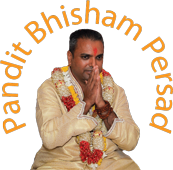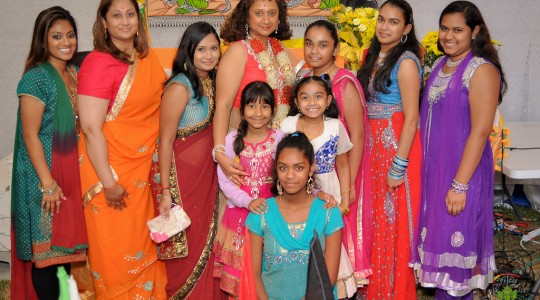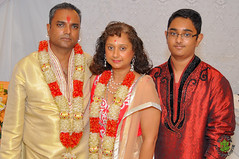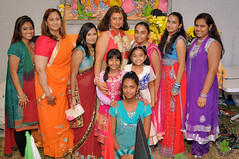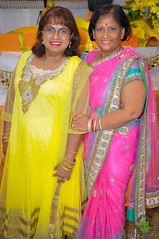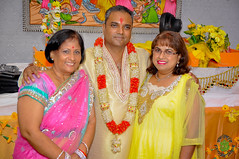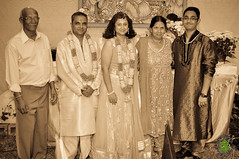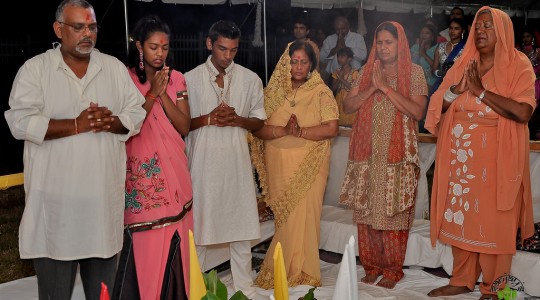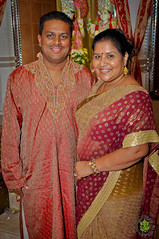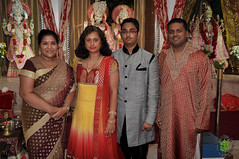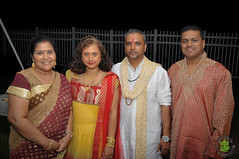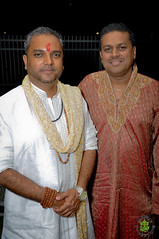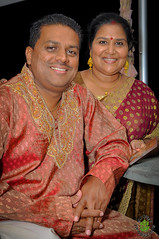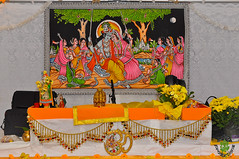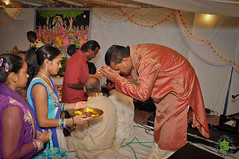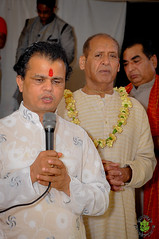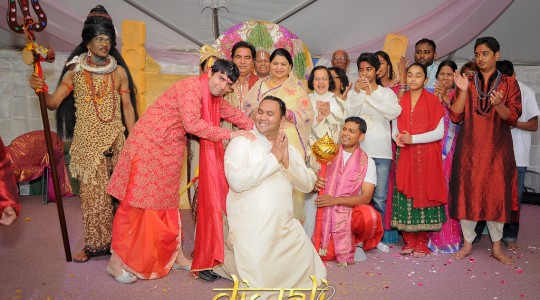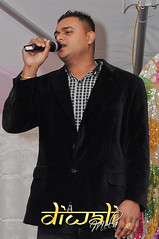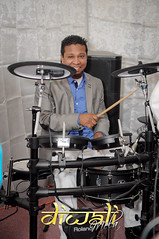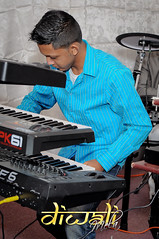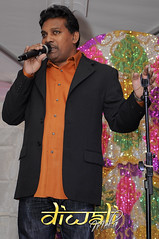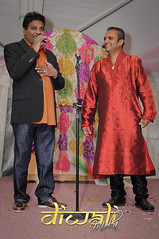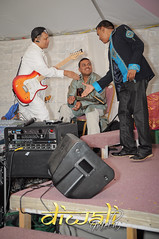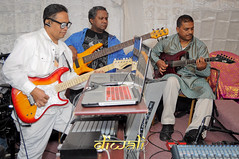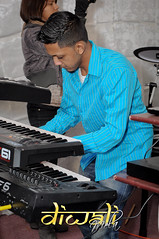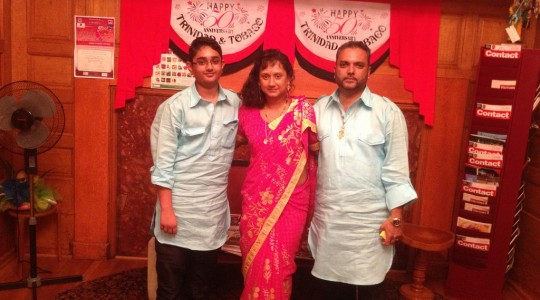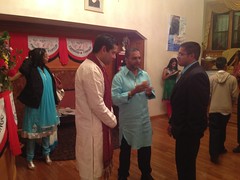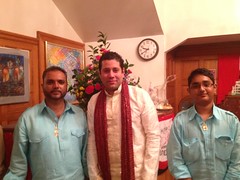Author archives: Admin
- 11 years ago
-
Ram Navami (Devanāgarī: राम नवमी) also known as Sri Rama Navami (IAST SriRām-navamī) is a Hindu festival, celebrating the birth of Lord Rama to King Dasharatha and Queen Kausalya of Ayodhya. Ram is the 7th incarnation of the Dashavatara of Vishnu.[1][2][3] Years later Lord Rama was married to Sita on the Vivaha Panchami. The sacred marriage of Devi Sita with Lord Rama was held on Margashirsha Shukla Panchami as per Valmiki Ramayana (This occasion is known as Seetha kalyanam). The SreeRama Navami festival falls in the Shukla Paksha on the Navami, the ninth day of the month of Chaitra in the Hindu calendar. Thus it is also known as Chaitra Masa Suklapaksha Navami, and marks the end of the nine-day Chaitra-Navratri celebrations.
At some places the festival lasts the whole nine days of the Navratras, thus the period is called ‘Sri Rama Navratra’.[4][5] It is marked by continuous recitals, Akhand Paath, mostly of the Ramacharitamanas, organized several days in advance to culminate on this day, with elaborate bhajan, kirtan and distribution of prasad after the puja and aarti. Images of infant form of Sri Rama are placed on cradles and rocked by devotees. Since Rama is the 7th incarnation of Vishnu having born at noon, temples and family shrines are elaborately decorated and traditional prayers are chanted together by the family in the morning. Also, at temples special havans are organized, along with Vedic chanting of Vedic mantras and offerings of fruits and flowers. Many followers mark this day by Vrata (fasting) through the day followed by feasting in the evening, or at the culmination of celebrations.[1][6][7] In South India,in Bhadrachalam the day is also celebrated as the wedding anniversary of Sri Rama and his consort Sita. Sitarama Kalyanam, the ceremonial wedding ceremony of the celestial couple is held at temples throughout the south region, with great fanfare and accompanied by group chanting of name of Rama, (Rama nama smaranam).[8][9] Whereas the marriage is celebrated in Mithila and Ayodhya during another day on Vivaha Panchami as per Valmiki Ramayana.
The important celebrations on this day take place at Ayodhya (Uttar Pradesh), Bhadrachalam (Andhra Pradesh) and Rameswaram (Tamil Nadu), thronged by thousands of devotees. Rathayatras, the chariot processions, also known as Shobha yatras of Rama, Sita, Lakshmana and Hanuman, are taken out at several places,[1][10][11] including Ayodhya where thousands of people take a dip in the sacred river Sarayu.[12]
History
In the epic Ramayana, Dasharatha, the Emperor from Ayodhya, had three wives named Kausalya, Sumitra and Kaikeyi in the Treta Yuga, which follows the Satya Yuga and is succeeded by Dwapara Yuga. Their greatest worry was that they had no children, and so they had no heir to the throne in the Ikshvaku Kula or royal lineage of great, pious, wonderful Emperors. Rishi Vasistha suggests him to perform Puthra Kamesti Yagna, through which he can have a desired child. He also tells him to invite Maharshi Rishyasringa to perform this yagna for him. Emperor Dasharatha consents and heads to Maharshi Rishyasringa’s ashram, to invite him. Maharshi agrees and accompanies Emperor Dasharatha to Ayodhya (Capital of Avadha) and performs the yagna. As the result of this yagna, Yagneshwara appears and provides Dasharatha a bowl of divine pudding (Kheer/Payasam) and requests him to give it to his wives. Dasharatha gives one half of the payasam to his elder wife Kausalya, and another half to his younger wife Kaikeyi. They both give half of their portions to Sumitra. After few days all three Queens conceive. On the ninth day (Navami) of Chaithra Masa (last month in Vedic calendar), at noon Kausalya gives birth to Rama, Kaikeyi gives birth to Bharata, and Sumitra to twin boys, Lakshmana and Shatrughna.Rama is the seventh incarnation of Vishnu, who takes birth by His own will, on Bhuloka (Earth) when Adharma rules over Dharma. He protects all his devotees by vanquishing the roots of Adharma. Rama decided to incarnate to destroy an Asura or person with demonic and evil designs, called Ravana.
Natal chart of Rama
Valmiki in his Sanskrit text Ramayan describes the natal or birth chart of young Rama,[13] and this day is celebrated as Ramanavami festival throughout India and amongst Indian diaspora:[14]
“ “On completion of the ritual six seasons have passed by and then in the twelfth month, on the ninth day of Chaitra month [March–April], when the presiding deity of ruling star of the day is Aditi, where the ruling star of day is Punarvasu (Nakshatra), the asterism is in the ascendant, and when five of the nine planets viz., Sun, Mars, Jupiter, Saturn, and Venus are at their highest position, when Jupiter with Moon is ascendant in Cancer, and when day is advancing, then Queen Kausalya gave birth to a son with all the divine attributes like lotus-red eyes, lengthy arms, roseate lips, voice like drumbeat, and who took birth to delight the Ikshwaku dynasty, who is adored by all the worlds, and who is the greatly blessed epitome of Vishnu, namely Rama.”
— Book I: Bala Kanda, Ramayana by Valmiki, Chapter (Sarga) 18, verses 8, 9, 10 and 11[15] ”Celebration
Followers of Hinduism in South India normally perform Kalyanotsavam (marriage celebration) with small deities murtis of Rama and Sita in their homes, and at the end of the day the deity is taken to a procession on the streets. This day also marks the end of the nine-day utsava called Chaitra Navaratri (Maharashtra) or Vasanthothsava (Karnataka, Andhra Pradesh & Tamil Nadu) (festival of Spring), which starts with Gudi Padwa (Maharashtra). According to recent astrological studies, some consider his date of birth to be January 10, 5114 B.C.E.[16][17]
A Home shrine with images of Rama, Sita, Lakshmana and Hanuman, on Sri Rama NavamiSome highlights of this day include
Kalyanam, a ceremonial wedding performed by temple priests
Panagam, a sweet drink prepared on this day with jaggery and pepper.
Procession of murtis in the evening, accompanied by playing with water and colours.For the occasion, Followers of Hinduism fast or restrict themselves to a specific diet in accordance to VedaDharma. Vedic temples are decorated and readings of the Ramayana take place. Along with SriRama, people also worship Sita, Rama’s wife; Lakshmana, Rama’s brother; and Hanuman, an ardent devotee of Rama and the leader of his army in the battle against the asura Ravana.
SriRama Navami is dedicated to remembering Rama, as the most supreme with resolute Bhakti (devotion). It occurs on the ninth day, or navami, beginning count from the “no moon day” or Amavasya, during the waxing moon duration called “Shukla Paksha”. Sri Rama Navami generally occurs in the months of March and April. Celebrations and festivities begin with prayer to the Surya Deva early in the morning. At midday, when Rama incarnated on that day in Treta Yuga, that duration is special and hence devotional service to him is performed with Bhakti and piety.
The Kalyanam performed in the Bhadrachalam Temple, in Andhra Pradesh is very famous.[18]
A number of ISKCON temples introduced a more prominent celebration of the occasion of the holiday with the view of addressing needs of growing native Hindu congregation. It is however always was a notable calendar event on the traditional Gaurabda calendar with a specific additional requirement of fasting by devotees.[19]
Sri Rama Navami is shared with Swaminarayan Jayanti, the birth of Swaminarayan, who was born in the village of Chhapaiya in the state of Uttar Pradesh.
Rama Rajya
Rama Rajya, the reign of Sri Rama is a rare duration of peace and prosperity bestowed by him alone. This festival commemorates the birth of Sri Rama who is remembered for his prosperous and righteous reign.In Northern India, an event that draws popular participation is the Rama Navami procession, also called Ratha Yatra. The main attraction in this procession is a gaily decorated chariot in which four persons enact the divine pastimes of Rama, His brother Lakshmana, His queen Sita and His pure devotee, Hanuman. The chariot is accompanied by several other persons dressed up in ancient costumes as Rama’s soldiers. The procession is a gusty affair with the participants praising echoing the blissful days of Rama’s rule as the Supreme Emperor on Bhuloka (Earth).
- 11 years ago
-
Raksha Bandhan, (the bond of protection) or Rakhi is a Hindu festival primarily observed in India, Mauritius and Nepal, which celebrates the relationship between brothers, cousins and sisters. It is also called Rakhi Purnima in most of India. It is also celebrated in some parts of Pakistan. The festival is observed by Hindus, and some Sikhs and Muslims. The central ceremony involves the tying of a rakhi (sacred thread) by a sister on her brother’s wrist. This symbolizes the sister’s love and prayers for her brother’s well-being, and the brother’s lifelong vow to protect her. The festival falls on the full moon day (Shravan Poornima) of the Shravan month of the Hindu lunisolar calendar. One Islamic Scholar believes that Raksha Bandhan grew in popularity after Rani Karnavati, the widowed queen of Chittor, sent a rakhi to the Mughal emperor Humayun when she required his help.
Rakhi Mantra
रक्षा-बंधन (सूत्र) मंत्र Raksha Bandhan (Rakhi Mantra)येन बद्धो बलि राजा, दानवेन्द्रो महाबल: | तेन त्वांमनुबध्नामि, रक्षे मा चल मा चल || राखी बांधते समय उपरोक्त मंत्र का उच्चारण करना विशेष शुभ माना जाता है | इस मंत्र में कहा गया है कि जिस रक्षा डोर से महान शक्तिशाली दानव के राजा बलि को बांधा गया था, उसी रक्षाबंधन से में तुम्हें बांधती हूं यह डोर तुम्हारी रक्षा करेगी |
Observance
The festival is marked by the tying of a rakhi, or holy thread, which comes in many colors and designs, by the sister on the wrist of her brother. The brother in return offers a gift to his sister and vows to look after her as she presents sweets to him. The brother usually presents his sister with an envelope filled with money, though other presents such as saris and clothing can be given. The brother and sister traditionally feed one another sweets. These sweets include anything from Jalebi, Kaju Katli, and Burfi. Since Indian kinship practices give cousins a status similar to siblings, girls and women often tie the rakhi to their male cousins as well (referred to as “cousin-brothers” in regional parlance) in several communities. Unrelated boys and men who are considered to be brothers (munh-bola bhai or adopted brothers) can be tied rakhis, provided they commit to a lifelong obligation to provide protection to the woman or girl.Mythical and Historical Occurrences and Mentions
Santoshi Ma
Ganesh had two sons, Shubh and Labh. On Raksha Bandhan, Ganesh’s sister visited and tied a rakhi on Ganesh’s wrist. Feeling and his two wives, Riddhi and Siddhi, for a sister. Finally, Ganesh conceded the demand, and Santoshi Ma (literally the Mother Goddess of Satisfaction) was created by divine flames that emerged from Riddhi and Siddhi.Krishna and Draupadi
Another incident from the epic Mahabharat concerns Krishna and Draupadi, the wife of the Pandavas. She had once torn a strip of silk off her sari and tied it around Krishna’s wrist to stanch the bleeding from a battlefield wound. Krishna was touched by her action and declared her to be his sister, even though they were unrelated. He promised to repay the debt and then spent the next 25 years doing just that. Draupadi, in spite of being married to five great warriors and being a daughter of a powerful monarch, trusted and depended wholly on Krishna. Krishna repaid the debt of love during the “Cheer-Haran” (literally “clothing-removing”) of Draupadi, which occurred in the assembly of King Dhritarashtra when Yudhisthira lost her to the Kauravas in gambling. At that time, Krishna indefinitely extended her saree through divine intervention, so it could not be removed, to save her honor. This is how he honored his rakhi vow towards Draupadi.Indra and Indrani
According to this legend, a battle was being fought between the deities and the demons during the Hindu month of Shravana on a full moon day. It is said that the demons were in a dominating position and this troubled Lord Indra. His wife Indrani, unable to see his husband saddened over losing the battle, prayed to God and prepared a sacred thread which she tied on the right wrist of her husband. As a result, not only did Lord Indra end up winning the battle but also escaped from it unhurt.The thread colour was red so it made red Raksha Bandhan popular among lovers.
King Bali and Goddess LaxmiAccording to a legend the Demon King Bali was a great devotee of Lord Vishnu. Lord Vishnu had taken up the task to guard his kingdom leaving his own abode in Vaikunth. Goddess Lakshmi wished to be with her lord back in her abode. She went to Bali disguised as a woman to seek refuge till her husband came back.
During the Shravan Purnima celebrations, Lakshmi tied the sacred thread to the King. Upon being asked, she revealed who she was and why she was there. The king was touched by her goodwill for his family and her purpose and requested the Lord to accompany her. He sacrificed all he had for the Lord and his devoted wife.This thread was yellow that made yellow Raksha Bandhan popular among brothers and sisters.
Thus, devotion to the Lord. It is said that since then it has been a tradition to invite sisters in Shravan Purnima for the thread tying ceremony or the Raksha Bandhan
Yama and the Yamuna
According to another legend, Raksha Bandhan was a ritual followed by Lord Yama (the Lord of Death) and his sister Yamuna, (the river in northern India). Yamuna tied rakhi to Yama and bestowed immortality. Yama was so moved by the serenity of the occasion that he declared that whoever gets a rakhi tied from his sister and promised her protection, will become immortal.Alexander the Great and King Puru
According to one legendary narrative, when Alexander the Great invaded India in 326 BCE, Roxana (or Roshanak, his wife) sent a sacred thread to Porus, asking him not to harm her husband in battle. In accordance with tradition, Porus, a Katoch king, gave full respect to the rakhi. On the battlefield, when Porus was about to deliver a final blow to Alexander, he saw the rakhi on his own wrist and restrained himself from attacking Alexander personally.Rabindranath Tagore & Rakhi
Tagore’s vision of celebrating Raksha Bandhan was totally different. According to him Rakhi is not only a festival of the siblings but it’s a celebration of mankind and of humanity. He promoted the concept of unity and harmony among all members of the society. He believed that it is the responsibility of all the members of the society to help and protect each other and encourage a harmonious social life. For him Rakshabandhan festival is the celebration of fellow feeling and concern. Especially in today’s context Tagore’s vision is very much applicable as it teaches us to think and care for others. The history behind this festival dates back to the year 1905 when the British empire decided to divide Bengal, a state of British India on the basis of caste and religion. That time Rabindra Nath Tagore arranged a ceremony to celebrate Raksha Bandhan to strengthen the bond of love and togetherness between the Hindus and the Muslims of Bengal and together fight against the British empire. He used the platform of Raksha Bandhan to spread the feeling of brotherhood. It was his vision to spread the nationalist spirit among people from different ethnic groups. His literary works have always transcended race, gender, religion and geographical boundaries. In his works and his beliefs he has always felt that it is important to have freedom of mind irrespective of race, religion and culture.According to him if we can think beyond our religion and caste than only we can become true human beings. So to spread this message of love he thought Raksha Bandhan to be the most appropriate day to spread this message. Rabindranath Tagore in Shantiniketan started congregations like Rakhi Mahotsavas. This invoked trust and feeling of peaceful coexistence. The festival for them is a symbol of harmony. The tradition continues as people tie rakhis to the neighbors and close friends. It is a festival denoting National sentiments of harmony. So if we look in to the actual significance of this festival in today’s world, which is full of crisis and strife, these kinds of rituals hold the key to peaceful existence. The auspicious day of Raksha Bandhan can be used as a potent tool for social change, which could ultimately envelop everyone in a permanent bond of love and friendship. Tagore used a white threads for Raksha Bandhan thus made white Raksha Bandhan popular among Friends.
Rani Karnavati and Emperor Humayun
A popular narrative that is centered around Rakhi is that of Rani Karnavati of Chittor and Mughal Emperor Humayun, which dates to 1535 CE. When Rani Karnavati, the widowed queen of the king of Chittor, realised that she could not defend against the invasion by the Sultan of Gujarat, Bahadur Shah, she sent a Rakhi to Emperor Humayun. Touched, the Emperor immediately set off with his troops to defend Chittor. Humayun arrived too late, and Bahadur Shah managed to sack the Rani’s fortress. Karnavati, along with a reported 13,000 other women in the fortress, carried out Jauhar on March 8, 1535, killing themselves to avoid dishonor while the men threw the gates open and rode out on a suicidal charge against Bahadur Shah’s troops. When he reached Chittor, Humayun evicted Bahadur Shah from fort and restored the kingdom to Karnavati’s son, Vikramjit Singh. Although contemporary commentators and memoirs do not mention the Rakhi episode and some historians have expressed skepticism about it, it is mentioned in one mid-seventeenth century Rajasthani account.Other festivals on this day
In southern and central parts of India including Kerala, Andhra Pradesh, Tamil Nadu, Karnataka, Maharashtra and Orissa, this day (i.e. Shravan Poornima day), is when the Brahmin community performs the rituals of Avani Avittam or Upakarma.Balarama Jayanti
This is also celebrated as Shri Baladeva birth Ceremony. Lord Krishna’s elder Brother Prabhu Balarama was born on this Poornima.Raksha Bandhan celebrations in India and Nepal
While Raksha Bandhan is celebrated all over the country, different parts of the country mark the day in different ways.In Nepal, Raksha Bandhan is celebrated on shravan purnima. It is also called Janai Purnima (Janai is sacred thread and purnima means full moon). Janai is changed in this day, in Brahmins and Kshetry families. A sacred thread is tied on wrist by senior family members and relatives. Nepalese people enjoy this festival, eating its special food “Kwati”, a soup of sprout of seven different grains.
Rakhi Purnima
Rakhi is celebrated as Rakhi Purnima in North India. The word “Purnima” means a full moon night.Gamha Purnima
Rakhi is also celebrated as Gamha Purnima in Orissa. On this date, all the domesticated Cows and Bullocks are decorated and worshipped. Various kinds of country-made cakes called Pitha and sweets mitha are made and distributed within families, relatives and friends. In Orissan Jagannath culture, the lord Krishna & Radha enjoy the beautiful rainy season of Shravana starting from Shukla Pakhya Ekadashi (usually 4 days before Purnima) and ending on Rakhi Purnima with a festival called Jhulan Yatra. Idols of Radha-Krishna are beautifully decorated on a swing called Jhulan, hence the name Jhulan Yatra.Narali Purnima
In western India and parts of Maharashtra, Gujarat, and Goa this day is celebrated as Narali Purnima. On this day, an offering of a coconut (naral in Marathi) is made to the sea, as a mark of respect to Lord Varuna, the God of the Sea. Narali Purnima marks the beginning of the fishing season and the fishermen, who depend on the sea for a living, make an offering to Lord Varuna so that they can reap bountiful fish from the sea.Jandhyam Poornima
Jandhyam is Sanskrit for sacred thread, and Poornima denotes the full moon in Sanskrit.The people of the Kumaon region of Uttarakhand, celebrate Raksha Bandhan and Janopunyu(जन्यो पुन्यु) on the Shravani Purnima, it is a day on which people change their janeu जनेयु or जन्यो (sacred thread). On this day, the famous Bagwal fair is held at Devidhura in district Champawat. Punyu in Kumauni means Purnima or full moon it is the purnima in which the sacred thread Janeu or Janyo is ceremonially changed. The Raksha Bandhan celebrations are similar all across North India. The thread changing ceremony is done all over India.
Kajari Purnima
In central parts of India such as Madhya Pradesh, Chattisgarh, Jharkand and Bihar this day is celebrated as Kajari Purnima. It is an important day for the farmers and women blessed with a son. On the ninth day after Shravana Amavasya, the preparations of the Kajari festival start. This ninth day is called Kajari Navami and varied rituals are performed by women who have sons until Kajri Purnima or the full moon day.Pavitropana
In parts of Gujarat, this day is celebrated as Pavitropana. On this holiday, people perform the grand pooja or the worship of Lord Shiva. It is the culmination of the prayers done throughout the year.Jhulan Purnima, Poonal/Jandhya Poornima/ Janyu
According to Bengali Culture and Celebration, in the state of West Bengal (India), this day is also called Jhulan Purnima. Prayers and puja of Lord Krishna and Radha are performed there. Sisters tie rakhi to Brothers and bestow immortality. Political Parties, Offices, Friends, Schools to colleges, Street to Palace celebrate this day with a new hope for a good relationship. Brahmins in Tamil Nadu, Andhra Pradesh, Karnataka, Konkan, and Orissa change their sacred threads on the same day (Janayu, called as Poonal in Tamil, Jandhyam in Sanskrit)
- 11 years ago
-
Navratri is the Hindu festival of worship and dance. In Sanskrit the term literally means “nine nights”. During this festival the forms of Shakti are worshiped.
Navratri (Hindi: नवरात्री Gujarati: નવરાત્રી Bengali: নৗরাতরী Assamese:নৱৰাত্রি Marathi: नवरात्री Punjabi: ਨਰਾਤੇ Kannada: ನವರಾತರೀ Kashmiri: نَورات / नवरात Telugu: నవరాతరీ Tamil: நவராதரீ Malayalam: നവരാത്രി) is a festival dedicated to the worship of the Hindu deity Durga. The word Navaratri literally means nine nights in Sanskrit, nava meaning nine and ratri meaning nights.[2] During these nine nights and ten days, nine forms of Shakti/Devi are worshiped. The 10th day is commonly referred to as Vijayadashami or “Dussehra.” Navratri is a very important and major festival in the western state of Gujarat,Maharashtra,karnataka during which the traditional dance of Gujarat called ‘Garba’ is widely performed. This festival is celebrated with great zeal in North India as well including Bihar, West Bengal, Madhya Pradesh and the northern state of Punjab.Significance
Garba dance in Ahmedabad during navaratri festivitiesThe beginning of spring and the beginning of autumn are considered to be important junctions of climatic and solar influence. These two periods are taken as sacred opportunities for the worship of the Divine Mother Durga. The dates of the festival are determined according to the lunar calendar.
Navarathri represents celebration of Goddess Durga, the manifestation of Deity in form of Shakti [Energy or Power]. The Navarathri festival or ‘Nine Nights festival’ becomes ‘ten days festival’ with the addition of the last day, Vijayadashami which is its culmination. On all these ten days, the various forms of Mother Mahisasura-mardini (Durga) are worshiped with fervor and devotion.
Traditions of Navaratri
Durga Puja at Bagbazar Sarbajanin, North Kolkata.Navaratri is celebrated five times a year. They are Vasanta Navaratri, Ashadha Navaratri, the Sharada Navaratri, and the Paush/Magha Navaratri. Of these, the Sharada Navaratri of the month of Puratashi and the Vasanta Navaratri of the Vasanta kala are very important.
1. Vasanta Navaratri: Basanta Navaratri, also known as Vasant Navaratri, is the festival of nine days dedicated to the nine forms of Shakti (Mother Goddess) in the spring season (March–April). It is also known as Chaitra Navaratri. The nine days of festival is also known as Raama Navratri.
2. Gupta Navaratri: Gupta Navaratri, also referred as Ashadha or Gayatri or Shakambhari Navaratri, is nine days dedicated to the nine forms of Shakti (Mother Goddess) in the month of Ashadha (June–July). Gupta Navaratri is observed during the Ashadha Shukla Paksha (waxing phase of moon).
3. Sharada Navaratri: This is the most important of the Navaratris. It is simply called Maha Navaratri (the Great Navratri) and is celebrated in the ‘pratipada’ (first day) of the bright fortnight of the lunar month of Ashvina. Also known as Sharad Navaratri, as it is celebrated during Sharad (beginning of winter, September–October).
4. Paush Navaratri: Paush Navaratri is nine days dedicated to the nine forms of Shakti (Mother Goddess) in the month of Paush (December–January). Paush Navaratri is observed during the Paush Shukla Paksha (waxing phase of moon).
5. Magha Navaratri: Magha Navaratri, also referred as Gupta Navaratri, is nine days dedicated to the nine forms of Shakti (Mother Goddess) in the month of Magha (January–February). Magha Navaratri is observed during the Magha Shukla Paksha (waxing phase of moon).
Vasanta Navaratri
Mysore Palace in all its majesty during Dasara
Navaratri Golu, dolls and figurine display festival for girls and women in South IndiaThis is celebrated during Vasanta Rhitu (beginning of summer) (March- April). This is also known as Chaitra navarathri as it falls during the lunar month of Chaitra.
The Story of Vasanta Navaratri
In days long gone by, King Dhruvasindhu was killed by a lion when he went out hunting. Preparations were made to crown the prince Sudarsana. But, King Yudhajit of Ujjain, the father of Queen Lilavati, and King Virasena of Kalinga, the father of Queen Manorama, were each desirous of securing the Kosala throne for their respective grandsons. They fought with each other. King Virasena was killed in the battle. Manorama fled to the forest with Prince Sudarsana and a eunuch. They took refuge in the hermitage of Rishi Bharadwaja.The victor, King Yudhajit, thereupon crowned his grandson, Satrujit, at Ayodhya, the capital of Kosala. He then went out in search of Manorama and her son. The Rishi said that he would not give up those who had sought protection under him. Yudhajit became furious. He wanted to attack the Rishi. But, his minister told him about the truth of the Rishi’s statement. Yudhajit returned to his capital.
Fortune smiled on Prince Sudarsana. A hermit’s son came one day and called the eunuch by his Sanskrit name Kleeba. The prince caught the first syllable Kli and began to pronounce it as Kleem. This syllable happened to be a powerful, sacred Mantra. It is the Bija Akshara (root syllable) of the Divine Mother. The Prince obtained peace of mind and the Grace of the Divine Mother by the repeated utterance of this syllable. Devi appeared to him, blessed him and granted him divine weapons and an inexhaustible quiver.
The emissaries of the king of Benares passed through the Ashram of the Rishi and, when they saw the noble prince Sudarsana, they recommended him to Princess Sashikala, the daughter of the king of Benares.
The ceremony at which the princess was to choose her spouse was arranged. Sashikala at once chose Sudarsana. They were duly wedded. King Yudhajit, who had been present at the function, began to fight with the king of Benares. Devis helped Sudarsana and his father-in-law. Yudhajit mocked Her, upon which Devi promptly reduced Yudhajit and his army to ashes.
Thus Sudarsana, with his wife and his father-in-law, praised Devi. She was highly pleased and ordered them to worship her with havan and other means during the Vasanta Navarathri. Then she disappeared.
Prince Sudarsana and Sashikala returned to the Ashram of Rishi Bharadwaja. The great Rishi blessed them and crowned Sudarsana as the king of Kosala. Sudarsana and Sashikala and the king of Benares implicitly carried out the commands of the Divine Mother and performed worship in a splendid manner during the Vasanta Navarathri.
Sudarsana’s descendants, namely, Sri Rama and Lakshmana, also performed worship of Devi during the Sharada Navarathri and were blessed with Her assistance in the recovery of Sita.
Sharad Navaratri
Commences on the first and ends on the tenth day of the bright half of the lunar month Aswayuja/Asvina.‘The Navarathri festival has to be celebrated during the bright fortnight of the month of Asvina, in the order of pratipada, etc, until the navami ends,’ says the Dhaumya-vacana.
Navarathri in the year 2012 started on 16 October 2012 and ended on 23 October 2012 with Vijayadashami celebrated on 24 October 2012.
Forms of Shakti
Nine forms of Shakti are worshipped during the Navaratris. The Devis worshipped depend on the tradition of the region.Durga, the inaccessible one
Bhadrakali
Amba or Jagadamba, Mother of the universe
Annapoorna devi, The one who bestows grains (anna) in plenty (purna: used as subjective)
Sarvamangala, The one who gives joy (mangal) to all (sarva)
Bhairavi
Chandika or Chandi
Lalita
Bhavani
MookambikaRituals
A photo of the Srikanta Datta Narasimharaja Wadiyar, scion of the Wodeyar dynasty
Srikanta Datta Wadiyar, incumbent Maharaja of Mysore inaugurating first day of Mysore DasaraThe Navaratri commences on the first day (pratipada) of the bright fortnight of the lunar month of Ashvin. The festival is celebrated for nine nights once every year during the beginning of October, although as the dates of the festival are determined according to the lunar calendar, the festival may be held for a day more or a day less.
Navaratri is celebrated in different ways throughout India. In North India, all three Navaratris are celebrated with much fervor by fasting on all nine days and worshiping the Mother Goddess in her different forms. The Chaitra Navratri culminates in Ram Navami and the Sharad Navaratri culminates in Durga Puja and Dussehra. The Dussehra of Kullu in Himachal Pradesh is particularly famous in the North. Navratri festival in Gujarat is one of the main festivals. Garba is dance which people use to dance after the Durga Pooja with the groups and live orchestra or devotional songs.
The last four days of Sharad Navaratri take on a particularly dramatic form in the state of West Bengal in East India where they are celebrated as Durga Puja.[4] This is the biggest festival of the year in this state. Exquisitely crafted and decorated life-size clay idols of the Goddess Durga depicting her slaying the demon Mahishasura are set up in temples and other places. These idols are then worshiped for five days and immersed in the river on the fifth day.
In Western India, particularly in the state of Gujarat and Mumbai, Navratri is celebrated with the famous Garba and Dandiya-Raas dance. Since the past few years, the Government Of Gujarat has been organising the “Navratri Festival Celebrations” on a regular basis for the nine days of Navratri Festival in Gujarat. People from all over Gujarat and even abroad come to participate in the nine days celebrations. It is also popular throughout India and among Indian communities around the world including the UK, Canada and USA.
In Goa, zatra begins during Navratri, entire Antruz (Ponda) is highly ornated. The Saraswat Brahmin temples are beautifully decorated and the idols are taken out for worship. The idols are dressed and adorned with flowers, sandalwood paste, turmeric and kumkum. Devotees come during Navarathri to get the special darshan and what mostly a devotee awaits is the Kaul Prasad, which is as something given from the Gods and Goddess itself. The Deities are emblazoned with flowers and devotees or priests continue to worship the deity without even changing the flowers on them. At the end of the festive night the flowers are distributed as Prasad for the devotees. The Dasha Maitrikas (the 10 sisters of Goa) of the Saraswat Brahmins are taken out to worship – namely, Shantadurga, Aryadurga, Mahalasa, Katyayani, Mahamaya, Kamakshi, Vijayadurga, Bhumika, Mahalakshmi and Navadurga.
In South India, people set up steps and place idols on them. This is known as golu. Photos of typical golu displayed in Tamil Nadu style can be found here.
In Karnataka, Ayudha Puja, the ninth day of Mysore Dasara, is celebrated with the worship of implements used in daily life such as computers, books, vehicles, or kitchen tools. The effort to see the divine in the tools and objects one uses in daily life is central to this celebration, so it includes all tools that help one earn one’s livelihood. Knowledge workers go for books, pen or computers, farmers go for the plough and other agricultural tools, machinery for industrialists and cars/buses/trucks for the transportation workers—all are decorated with flowers and worshiped on this day invoking God’s blessing for success in coming years. It is believed that any new venture such as starting of business or purchasing of new household items on this day is bound to bring success and prosperity.
Mysore is well known for the festivities that take place during the period of Dasara, the state festival of Karnataka. The Dasara festivities, which are celebrated over a ten-day period, were first introduced by King Raja Wodeyar I in 1610.[5] On the ninth day of Dasara, called Mahanavami, the royal sword is worshipped and is taken on a procession of decorated elephants, camels and horses.[5] On the tenth day, called Vijayadashami, the traditional Dasara procession (locally known as Jumboo Savari) is held on the streets of Mysore. An image of the Goddess Chamundeshwari is placed on a golden mantapa on the back of a decorated elephant and taken on a procession, accompanied by tableaux, dance groups, music bands, decorated elephants, horses and camels.[5] The procession starts from the Mysore Palace and culminates at a place called Bannimantapa, where the banni tree (Prosopis spicigera) is worshipped.[5] The Dasara festivities culminate on the night of Vijayadashami with a torchlight parade, known locally as Panjina Kavayatthu.[5]
In Kerala, three days: Ashtami, Navami, and Vijaya Dashami of Sharad Navarathri are celebrated as Sarasvati Puja in which books are worshiped. The books are placed for Puja on the Ashtami day in own houses, traditional nursery schools, or in temples. On Vijaya Dashami day, the books are ceremoniously taken out for reading and writing after worshiping Sarasvati. Vijaya Dashami day is considered auspicious for initiating the children into writing and reading, which is called Vidyarambham. Tens of thousands of children are initiated into the world of letters on this day in Kerala.
In Telangana region of Andhra Pradesh, people celebrate Bathukamma festival over a period of nine days. It is a kind of navratri celebration.
Navratri is divided into sets of three days to adore three different aspects of the supreme goddess or goddesses.
Effigy of Ravana burnsFirst three days
The goddess is separated as a spiritual force called Durga also known as Kali in order to destroy all our impurities.Second three days
The Mother is adored as a giver of spiritual wealth, Lakshmi, who is considered to have the power of bestowing on her devotees inexhaustible wealth, as she is the goddess of wealth.Final three days
The final set of three days is spent in worshiping the goddess of wisdom, Saraswati. In order to have all-round success in life, believers seek the blessings of all three aspects of the divine femininity, hence the nine nights of worship.Eighth day is traditionally Durgashtami which is big in Bengal and Bihar
In some parts of South India, Saraswati puja is performed on the 9th day. Ayudha Puja is conducted in many parts of South India on the Mahanavami (Ninth) day with much fanfare. Weapons, agricultural implements, all kinds of tools, equipments, machinery and automobiles are decorated and worshipped on this day along with the worship of Goddess. The work starts afresh from the next day, i.e. the 10th day which is celebrated as ‘Vijaya Dashami’. Many teachers/Schools in south India start teaching Kindergarten children from that day onwards.
In North India, as the culmination of the Ramlila which is enacted ceremoniously during Dussehra, the effigies of Ravana, Kumbhakarna, and Meghanada are burnt to celebrate the victory of good (Rama) over evil forces on the ‘Vijaya Dashami’ day.
During Navratri, some devotees of Durga observe a fast and prayers are offered for the protection of health and prosperity. Devotees avoid meat, alcoholic drinks, grains, wheat and onion during this fast. Grains are usually avoided since it is believed that during the period of Navratri and seasonal change, grains attract and absorb lots of negative energies[6] from the surrounding and therefore there is a need to avoid eating anything which are produced from grains for the purification of Navratri to be successful. Navratri is also a period of introspection and purification, and is traditionally an auspicious and religious time for starting new ventures.
During this vowed religious observance, a pot is installed (ghatasthapana) at a sanctified place at home. A lamp is kept lit in the pot for nine days. The pot symbolizes the universe. The uninterrupted lit lamp is the medium through which we worship the effulgent Adishakti, i.e. Sree Durgadevi. During Navratri, the principle of Sree Durgadevi is more active in the atmosphere.
Navratri is celebrated in a large number of Indian communities. The mother goddess is said to appear in 9 forms, and each one is worshiped for a day. These nine forms signify various traits that the goddess influences us with. The Devi Mahatmya and other texts invoking the Goddess who vanquished demons are cited.
During the eight or ninth day, Kanya Poojan, pre-pubescent girls are ceremonially worshipped.
Food during Navratri FastThe Navratri fast is observed from the first day to the ninth day. Some devotees only observe fast during three days i.e., first fast during any one of the first three days and second fast during any one of the next three and last in any one of final three days. Some people confine to milk and fruits during the nine days. Most devotees take a single meal during the day. Non-vegetarian food is totally avoided.
- 11 years ago
-
Makar Sankranti (harvest festival also known by other various names) is the only Hindu festival which is based on the Solar calendar rather than the Lunar calendar. The festival is celebrated by taking dips in the Ganges river or any river and offering water to the Sun god. In Tamil Nadu this is popularly called Pongal, and special prayers and offerings are given the Sun to thank him for the harvest.
- 11 years ago
-
Maha Shivaratri is the great night of Shiva, followers of Shiva observe religious fasting and the offering of Bael (Bilva) leaves to the Shiva.
- 11 years ago
-
Janmashtami commemorates the earthly appearance of Krishna, who is described in India’s sacred writings as God Himself. One of the biggest religious festivals in the world, it is celebrated by nine hundred and thirty million people around the world–and two million in the US alone. To devotees, it’s Christmas and New Year’s in one, a day of deep spiritual renewal and celebration that effectively finishes an old year and begins a fresh one.
But why Janmashtami, you may ask? What’s so special about Krishna, as opposed to any other form of God? It’s His personable-ness. He reciprocates in unique, personal ways with every devotee who offers Him love—He is the most adorable, mischievous son, the most romantic lover, the most compassionate friend. And on Janmashtami, devotees celebrate Krishna in all of these aspects. For just as Krishna reciprocates individually with His relatives and confidantes, he responds to the distinct feelings and desires held most deeply in the heart of every single worshipper.
So remember that whatever way you worship Krishna on Janmashtami, He will reciprocate with you accordingly. It’s a meditation that makes for an extremely rewarding devotional experience.
How is Janmashtami Celebrated?
Where Vaishnava temples exist, festivities begin before dawn and extend all day until midnight, the exact moment of the anniversary of Krishna’s appearance. Events include kirtan, singing the Lord’s name along with other devotees; and japa, private, more intimate prayer. Some devotees cook a feast of over one hundred dishes, while others perform drama and dance. Some clothe and decorate the deity of Krishna while others string enormous flower garlands and other decorations for the temple. Incense burns, scriptures are read, and all but the young and the infirm fast all day. The deities are also bathed with a variety of auspicious liquids in a kind of ablution
ceremony called abhisheka. Sometimes taking over two hours, this is performed with great pomp.Finally, at midnight, priests pull apart the curtains to reveal the freshly dressed deity of Krishna on a creatively festooned and colored altar. The excitement builds, and a rousing kirtan ensues.
How to Celebrate Janmashtami at Home
But what if you don’t live near a temple? What if you can’t make it to a major celebration Does that mean you can’t observe Janmashtami? Of course not. It is our sincere devotion that pleases Krishna most, and this can be offered anywhere. So to help you feel more connected to the Lord and His devotees on this special day, here are Krishna.com’s tips on how to celebrate Janmashtami at home:Invite all your friends and family to participate in the festivities.
Decorating your home for Krishna can be fun, particularly for children. Encourage them in helping to make garlands, hanging balloons and festoons of leaves, and generally making the house beautiful for Krishna’s appearance.Get a copy of the Vaishnava Songbook and choose some of your
favorite bhajanas(devotional songs in praise of God) to sing. Krishna, also known as Murlidhara, or “one who holds the flute,” loves music. And so will your friends and family, as you take turns singing and playing instruments. Alternatively, play bhajan CDs and heighten the spiritual atmosphere.You can also chant extra rounds of the Hare Krishnamaha-mantra on your japa mala (prayer beads). This is an intimate one on one exchange with Krishna, and makes you feel much closer to the Lord.
Read the story of Krishna’s advent and other exciting pastimes from Krishna, the Supreme Personality of Godhead or Srimad Bhagavatam, Canto Ten. Pass the book around, and try dramatic readings to bring the story to life. Janmashtami is all about completely immersing yourself in thoughts of Krishna in a festive way.
If you have Radha-Krishna deities, get extra special new outfits for them. Exercise your creativity and pay special attention to decorating their altar.
Recreate the temple program and hold an abhisheka bathing
ceremony for your deities. Simply buy different liquids like yogurt,
honey, ghee and fruit juices and bathe the deity with them while
singing devotional songs.Temples prepare at least one hundred and eight different food dishes on Janmashtami. Of course, you don’t have to go that far, unless you’re feeling particularly energetic! But it’s always nice to cook some very special preparations to offer to the Lord. Imagine that Krishna was actually right there, in your house—what would you offer Him? This makes for a wonderful meditation while cooking on Janmashtami.
Have a midnight arati (worship ceremony) with a
kirtan. This is the exact time that Krishna appeared on this
planet, so it is most auspicious and spiritually inspiring. If you
have arati paraphernalia, then you can do a full offering. If
not, don’t worry–Krishna says in Bhagavad-gita, “If you
offer Me with love a leaf, flower, fruit or water, I will accept it.”
So offer whatever you can—it’s your love and devotion that matters.Tune into Krishna.com’s webcams and watch the festivities going on at some of ISKCON’s major temples.
Buy a special gift for the Lord. You can wrap it and write a card to Krishna. Here are some gift ideas:
If you have Deities you can buy or make jewelry, new clothes, garlands, peacock feathers, turban pieces, flutes or water cups
Incense
Fruit basket
Offering plate
New picture frame if you worship a picture of Krishna
Brand new aratisetIf you are able to fast from food, fasting until midnight is recommended. If fasting is too difficult, then try to eat only light foods during the day. By putting our own needs aside and concentrating more on Krishna’s, we show our love for Him.
You can engage your children in many of the above activities. Depending on your children’s ages, they can help cook, make garlands, design a birthday card, play musical instruments, dance and chant Hare Krishna. There are many children’s books about Krishna as well as DVDs of Krishna pastimes at the Krishna.com store.
Children also enjoy dressing up as Radha, Krishna and their associates, and re-enacting Krishna’s pastimes. This helps to create a very festive mood.
As you celebrate Janmashtami, remember that just as we enjoy the attention and fun on our birthday, so the Lord also enjoys our attention and gifts on His appearance day. The difference between us and Krishna is that He is able to reciprocate perfectly with each one of us. In the transcendental realm, everything that we offer to the Lord with love and devotion will benefit us unlimitedly, and those benefits will stay with us for eternity.
- 11 years ago
-
Holi or Phagwah is a popular spring festival. Holi commemorates the slaying of the demoness Holika by Lord Vishnu’s devotee Prahlad. Thus, the festival’s name is derived from the Sanskrit words “Holika Dahanam”, which literally mean “Holika’s slaying
- 11 years ago
-
Hanuman Jayanti is celebrated on the full moon day (pournima) of the Hindu lunar month of Chaitra. A special feature of Hanuman Jayanti is that according to some religious almanacs (panchangs) the birthday of Shri Hanuman falls on the fourteenth day (chaturdashi) in the dark fortnight of the month of Ashvin while according to others it falls on the full moon day in the bright fortnight of Chaitra. On this day, in a Hanuman temple spiritual discourses are started at dawn. Hanuman was born at sunrise. At that time the spiritual discourse is stopped and the offering of food (Prasad) is distributed to everyone.
Incidents in Shri Hanuman’s life and their significance
To provide assistance for the establishment of the Divine Kingdom: The main objective of Shri Hanuman’s life was to destroy obstacles in the establishment of the Divine Kingdom by providing the required warrior element. As a result, the embodied souls who would assist in the establishment of the Divine Kingdom were protected.
For this reason itself Shri Maruti manifests Himself in various forms during different Yugas. His task in the manifest-unmanifest form never ceases. Shri Maruti has humility in serving (i.e. Dasyabhav) to the extent of 100%. Thus He is constantly active.Assisting embodied souls in performing spiritual practice: Shri Maruti has always helped embodied souls do spiritual practice in various Yugas. In the Tretayuga Shri Maruti taught the right path of spiritual practice to the monkeys and helped them.
Liberating many souls: The embodied souls with an intense desire for spiritual practice were granted liberation by Shri Maruti even at the cost of His own powers. He liberated many souls from existence in their cursed class by using His mace.
An example of a perfect Sevak: Shri Maruti presented an example of a perfect sevak. As a result, many embodied souls attained Final Liberation by following the same path i.e. Dasyatva. Due to His humility only He was able to narrate the good qualities of Shri Rama to Ravan and when Ravan denigrated Shri Rama, Maruti burnt Lanka and returned safely.
Ritualistic worship
1. Ritualistic worship of Shri Hanuman (Maruti) There is a specific science to the ritualistic worship of each Deity. This means that, actions done in a particular way during the ritualistic worship, have a specific underlying science. Just by following these actions, we can get maximum benefit of that Deity’s Principle. The following questions and answers contains the divine knowledge received by the seekers regarding exactly how some routine actions should be performed during the ritualistic worship of Shri Hanuman (Maruti).1. Applying sindoor
Q. – How should a worshipper apply sindoor before starting the ritualistic worship of Maruti ?
Ans. – Sindoor should be applied with the ring finger.2. Offering flowers
Q. – Which flowers should be offered? In what number? What is the method of offering the flowers ?
Ans. – Flowers and leaves of calotropis (ruee) Five or multiples of five. The stems of flowers should be turned towards the Deity.3. Waving incense sticks
Q. – Incense sticks of which fragrances should be used? How many incense sticks should be used ? What is the method of waving ?
Ans. – Kewda, Chameli (Jasmine) and Ambar. Two incense sticks. Holding them between the index finger and thumb of the right hand, the incense sticks should be waved thrice, in a clockwise direction, in a full circle.4. Circumambulation
Q. – How many circumambulations should be performed around Maruti ?
Ans. – Minimum five but if a worshipper wants to perform more, then they should be in multiples of five.Prevalent ritualistic worship
In Maharashtra, Saturday is considered to be the day of Maruti while in rest of India (Bhaarat) both Tuesday and Wednesday are considered to be His days. There is a custom of offering sindoor and oil to Maruti on these days. Breaking a coconut in front of Maruti also appears to be an age old custom. For spiritual progress, Maruti with His face to the left (Vaammukhi Maruti) or Maruti with an attitude of service (Daas Maruti) is worshipped.Saade-saati of Saturn (Shani) and the ritualistic worship of Shri Hanuman
While enduring a Saade-saati of Saturn, Maruti is worshiped to reduce the distress caused by Saturn. The ritual is as follows:Oil is taken in a bowl and 14 black urad grains are put in it. Thereafter one sees the reflection of his face in the oil. The oil is then offered to Maruti. The method of worship remains the same even when a person is sick and cannot visit a temple. The reflection of negative energy also takes place along with the reflection of ones face. When such oil is offered to Maruti, the negative energy therein gets destroyed. A true oil-merchant does not sell oil on Saturday because the negative energy causing distress to a person, who is going to offer the oil to Maruti, is likely to attack the oil merchant. Therefore one should not buy oil from the vendors sitting outside the Maruti temple but should bring it from his own house instead.
Use of Brahmatej and Kshatratej as required
The sacred thread (Janeu) on Hanuman’s left shoulder is a sign of Brahmatej. Since Shri Maruti is an incarnation of Shri Shiva He has destructive powers too. Yet, because of His devotion to Shri Rama, Vishnu-tatva developed in Him. Since Maruti adorns Brahmatej and Kshatratej during wars, He can use both as required. During the war between the Kauravas and Pandavas, Shri Krishna seated Maruti on Arjun’s chariot (He can be seen on the flag at the top of Arjun’s chariot). Hanuman destroyed the weapons, directed at Arjun and his chariot, in mid-air itself.Install the warrior posture idol of Shri Hanuman
To get the benefit of the gross, manifest and destroyer element, we should avoid installing an idol of Maruti in the seated posture. Amongst the seven higher Deities (Shiva, Ganapati, Rama, Krishna, Datta, Maruti and Durga), Shri Hanuman’s element (tatva) is of a gross, manifest and destroyer nature. The word ‘Hanuman’ means – ‘One whose ‘roar’ cannot be fathomed even by the Gods’. When Gods perform a destructive activity, they use the ‘Maruti’ element (which moves at the speed of wind) as a medium to appear in the Universe. Hence He is referred to as Maruti. The roar of Shri Maruti is capable of activating the element of any higher Deity in the Universe who is engrossed in deep meditation. Similarly, it also possesses the power to shake all the fourteen planes (Saptalok and Saptapatal).Maruti in seated posture depicts the unmanifest form of power. Maruti in a warrior posture depicts the manifest form of power. To obtain the benefit of the gross, manifest and destroyer element, we should avoid installing a seated idol of Maruti in a temple. Maruti in a seated position implies He is in deep meditation, wherein His motor organs are in a dormant, inactive state. Thus, the common man will be able to derive very little benefit from this posture of Maruti. When the spiritual level of an embodied soul is above 60%, it is capable of activating the element present in an idol in meditation, through his devotion.
